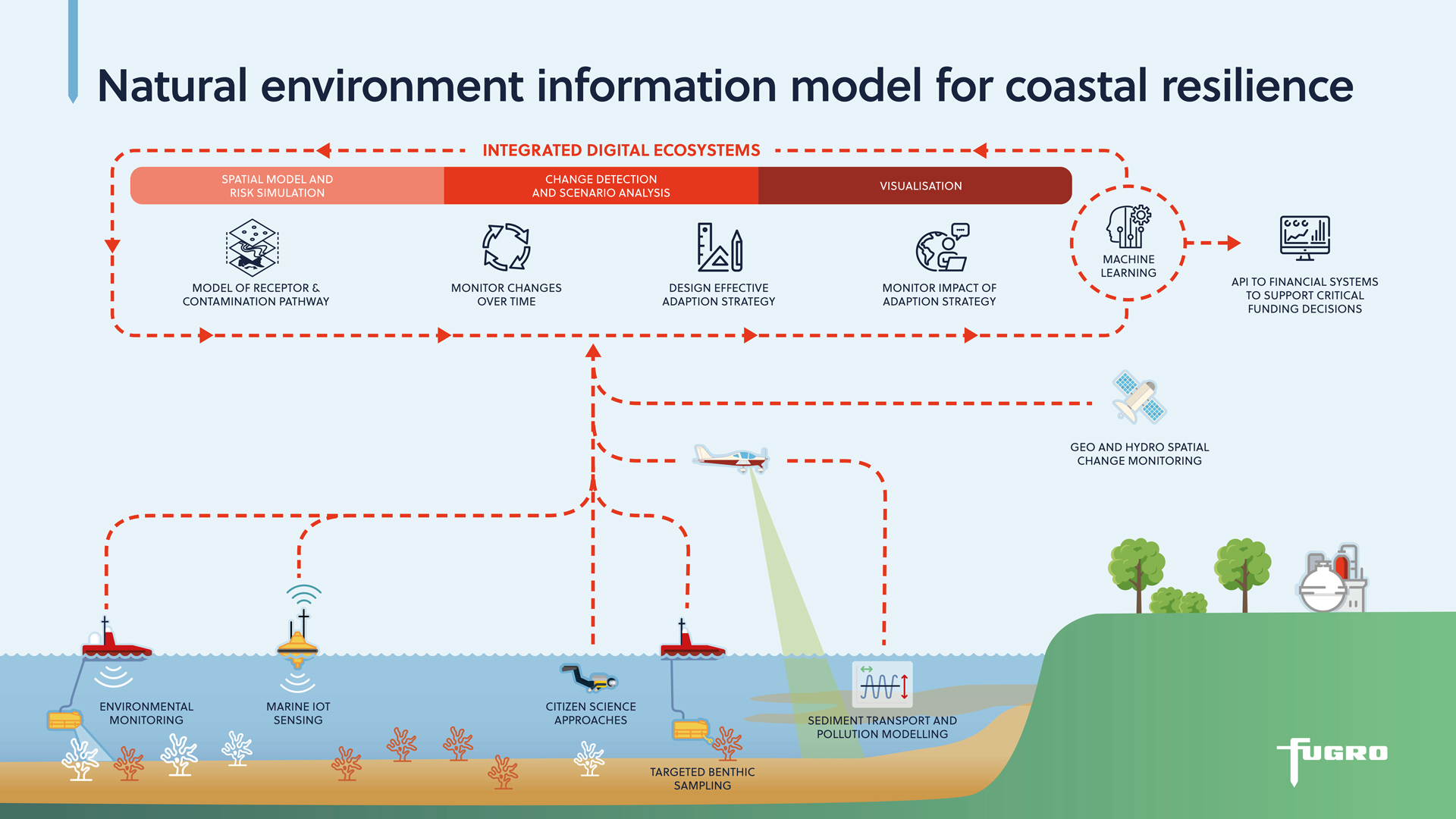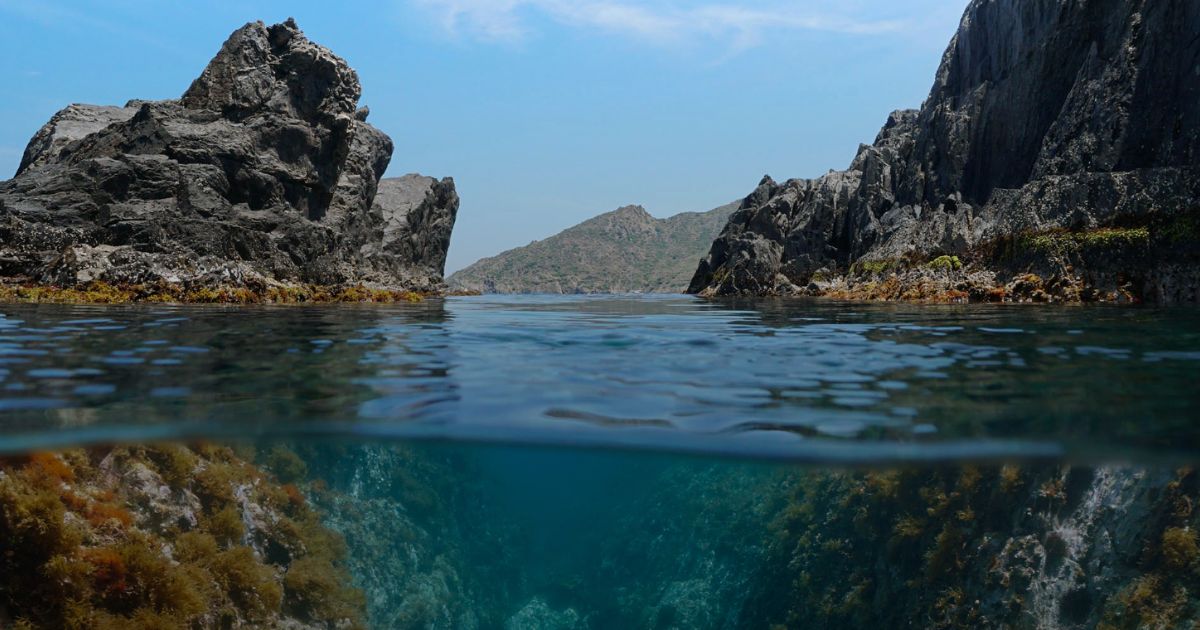By Tom Parry & Talia Sherrard
We are at the dawn of a new era; one in which the natural environment is seen and valued, not just for its beauty but also for its ability to protect us from the physical consequences of climate change. To make amends for the damage caused by human actions, Geo-data is crucial on this journey to achieve the required level of funding.
Coastal zones are reliant on our natural ecosystems, such as mangrove forests, coral reefs and sea grass beds. These natural environments provide coastal communities with protection from extreme weather events, vital resources from aquaculture and support biodiversity. Increasing climate impacts and urbanization threatens coastal and marine natural capital with changing and compounding geohazards, such as increased storm activity, sea level rise, UV exposure and ocean acidification alongside anthropogenic hazards.
Geo-data plays a central role in understanding and quantifying these risks and digital twins are key to sharing these insights. Access to organized and high-resolution Geo-data will be vital in unravelling the complex relationships between changing hazards and the impact on natural capital ecosystems.
 Why Go to This Level of Understanding?
Why Go to This Level of Understanding?
The WWF’s living planet index identified that the economic value of nature is worth an estimated $125 trillion of which the blue economy is worth around $24 trillion. The World Economic Forum reported that between 2020 to 2030, approximately $2.7 trillion are required per year from private investment funds to scale the transition and deploy technological innovation effectively. Adaptation investment is notoriously difficult to track due to challenges associated with context dependency and the uncertain causality of investments made.
To achieve this capital, greater certainty to reduce adaption investment risk is a must. During assessments of these ecosystems through scientific methods, we need to address the key questions of why and how something is happening and deliver the insights that key decision makers require. Through initiatives such as geospatial finance and the development of parametric insurance systems, technological advancements are being made to support the linking of financial decisions with Geo-data.
Targeting the Cause, not the Symptoms
Harnessing the value of global open-source models such as the Allen Coral Atlas and ocean models being developed through initiatives like the Digital Twins of the Ocean (DITTO) and European Marine Observation and Data Network (EMODnet), will be vital in gaining a better understanding of the issues. Linking localized approaches to these digital twins will also help further our understanding of these complex ecosystems.
Using advanced AI and cloud technologies with the right Geo-data at a specific site can help us diagnose the impact of changes. This allows us to understand why something is happening and confidently predict what is likely to happen in the future to advise on sustainable actions. This will help decision makers unlock the finance needed to deliver robust protection strategies, manage these impacts and restore our natural marine ecosystems.
How a Natural Ecosystem Information Model Can Help
Like the building information models (BIM) used to manage information about the built environment, natural ecosystem information models (NIM) provide a representative digital twin that integrates various datasets to understand how measured variables impact change in the ecosystem’s health over time by:
- Using open-source ocean models to understand potential changes that influence marine natural capital and develop robust monitoring plans,
- Using edge to cloud technologies that integrate a variety of IoT monitoring techniques and advanced technologies to measure observed changes, potential hazards and pathways,
- Using remote and autonomous technologies and high-resolution hydrospatial methods to measure changes within marine natural capital systems over time,
- Linking modeled and observed Geo-data analysis about these measured variables to diagnose changes in the ecosystem, support predictive learning through AI and inform financial systems through 5D impact analysis.
With any potential solution, the value of local communities must not be overlooked. These communities interact and rely on these ecosystems daily. Exploring digital processes that allow local initiatives and citizen science approaches to be set up as the value of data from this daily interaction would offer vital insights in ground truthing NIM.
In Conclusion
The journey to understanding our oceans and natural ecosystems will require detailed digital twins at both a global and local level. This journey will be complex, requiring extensive Geo-data and many stakeholders working together across science, engineering, finance, and politics. The digital twins will provide us with the right tool to organize and access information in a way that we can understand how to act and through initiatives like DITTO and EMODnet we are finding ways of working together effectively to help restore and preserve our natural capital.
Did You Know?
- Nature is declining at an unprecedented rate with nearly 1 million species at risk of extinction because of human activity
- $44 trillion of economic value generation – over half the world’s total GDP – is potentially at risk as a result of dependence of business on nature and its services
- Biodiversity loss and ecosystem collapse is ranked as one of the top five threats humanity will face in the next 10 years
- Climate change is currently responsible for between 11 % and 16 % of biodiversity loss and is expected to increase



